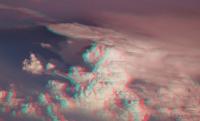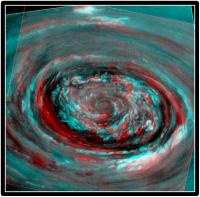Printable Version of Topic
Click here to view this topic in its original format
Unmanned Spaceflight.com _ Earth Observations _ Clouds in 3D
Posted by: ngunn Jun 6 2014, 01:35 PM
The last time we discussed this, I think, was around the time of the UMSF balloon flight. The idea was to use images of clouds obtained at intervals fom an ascending balloon as stereo pairs. Horizontally separated successive images from a plane could potentially work the same way. I think someone (ugordan?) had a go at doing this. IIRC the enemy was - time. The clouds changed too much in the time interval necessary beween shots for good 3D images to be obtained.
But now we have the marvellous HDEV from the ISS, a very fast moving platform! Images separated by just a few seconds should be wide enough apart to use for 3D without the clouds themselves having time to change significantly. I can imagine a split screen view from the downward pointing camera, with a short delay on one side relative to the other. Viewing this as cross-eye should generate a 3-D movie showing not only clouds but also mountains rising upward toward the viewer.
Of course I haven't a clue how to accomplish this but I bet there are a few folks here who could, or maybe even have already. Does anybody else think it might be worth a go?
Posted by: Gerald Jun 6 2014, 02:12 PM
I'd guess, all you need to do, is to use two copies of the video sequence, one with a delay of a few seconds, rotate the frames according to the direction of motion, use one copy as left eye, the other as right eye sequence.
For a test, whether there is enough depth, two images taken with the supposed delay would be sufficient.
Posted by: djellison Jun 6 2014, 02:20 PM
Take a couple of screenshots a few seconds apart and try it.
I had a go a few weeks ago basically without success.
Posted by: ngunn Jun 6 2014, 05:24 PM
Brilliant! Well done. ![]() How many seconds gap did you use?
How many seconds gap did you use?
Posted by: Gerald Jun 6 2014, 05:33 PM
Thanks! (I won't make a movie.)
In this case I waited until the scene has moved 37% the width of the (uncropped raw) image. Unfortunately the camera switched rather frequently; that way it wasn't quite easy to grab a nice cloud with a long baseline.
Posted by: JohnVV Jun 6 2014, 08:42 PM
I have not tried this yet, so.....
Stereo pipeline should be able to do that from the iss images
use each frame as a base pair and the iss orbit ground track as the distance from frame to frame
for the left/right distance
create a *.pc and export it as a mesh or use the z-axis pc file as a height map for a render
blender,maya,pov-ray,...
Posted by: bill davis Jun 8 2014, 09:25 PM
I do 3-D clouds from the ISS frequently. I use StereoPhotoMaker and just combine the images. I go here for the raw images http://eol.jsc.nasa.gov/
As far as doing 3-D pairs with HDEV it's possible but the cameras are usually pointed at the horizon and you really want them looking downward or oblique.
https://m.flickr.com/#/photos/billdavis6959/
Posted by: ngunn Jun 9 2014, 05:44 AM
That is truly spectacular. Please post more here as you do them. ![]()
Posted by: bill davis Jun 9 2014, 03:15 PM
Thanks, the main problem in doing these stereo pictures from the ISS may be the sheer number of images that you have to go through to find a usable pair. There are easily over a million images in the database at "The Gateway to Astronaut Photography of the Earth" (http://eol.jsc.nasa.gov/) and you will go blind before you can ever see them all. A fast connection with dual monitors helps and I would recommend filtering only the images taken with 400mm lens and above. If you have a series of images of a specific scene skip a few to provide a better baseline for hyper-stereo effect. I cannot emphasize enough the program StereoPhotoMaker, it will make this type of work much easier...
Posted by: ngunn Jun 9 2014, 10:50 PM
That's where HDEV comes in handy. Any two images 15 or 20 seconds apart will do. The downard pointing camera is selected often enough that there are plentiful opportunities.
Posted by: ngunn Jun 10 2014, 06:16 PM
I found some more cloud anaglyphs here: http://www.google.co.uk/imgres?imgurl=http%3A%2F%2Fone1more2time3.files.wordpress.com%2F2012%2F08%2Fclouds-3d-00106.jpg&imgrefurl=http%3A%2F%2Ftwelvefield.wordpress.com%2F2012%2F08%2F&h=953&w=1400&tbnid=8kpPLehQ_V6paM%3A&zoom=1&docid=28haPw9ZZXXq2M&ei=EEmXU9DiBfKh7Aacv4CoCw&tbm=isch&client=firefox-a&ved=0CGYQMyg6MDo&iact=rc&uact=3&dur=1229&page=4&start=43&ndsp=17
Posted by: bill davis Jun 11 2014, 01:14 AM
I think this kind of imagery would be useful for the above mentioned time delay method of stereo video.
If you have never heard of Skybox Imaging you may be surprised by this new non-government capability of real time high resolution video from orbit.
I tried running two VLC windows side by side and screen grabbing to create X-view video but the results were less than satisfactory.
http://vimeo.com/92072374
Posted by: bill davis Aug 4 2014, 03:37 AM
Here is a website that runs the HD video from the ISS in two windows to enable cross-view stereo.
A very slight delay on the right window gives good 3-D effect depending on the direction of the view.
http://www.satflare.com/iss3dhd/#video3d
Posted by: ngunn Aug 4 2014, 03:34 PM
Great find! Thanks for posting.
Posted by: droidtoaster Sep 17 2014, 03:28 AM
Has this technique (multiple images from a single camera on a fast moving platform relative to subject) ever been successfully applied to any of the Jovians?
For example, I always thought the cloud banding of Jupiter looked '3D' even in single images, with areas of clear depth among the formations.
Or are the image intervals relative to all other motions just not in the ballpark for creating fuseable image pairs?
If not I may have to add this to my to-do list...
Posted by: bill davis Sep 17 2014, 04:24 AM
I have not found any usable pairs from Jupiter yet.
Saturn provides a lot more material to work with...
Posted by: scalbers Feb 26 2019, 12:34 AM
Now that it's 2019 we can look at a stereo combo animation with GOES-17 and Himawari, courtesy of the Wisconsin CIMMS folks:
http://cimss.ssec.wisc.edu/goes/blog/wp-content/uploads/2019/02/G17H8_VIS_20FEB_2000_to_21FEBRUARY2019_0450anim.gif
Posted by: monty python Feb 26 2019, 07:43 AM
Someone call Brian May. He loves this stuff. I just hope the parallax is good enough.
Posted by: scalbers Feb 26 2019, 06:21 PM
Yes - maybe when Brian M. returns from the Oscars ![]()
The parallax is plenty good or even a bit on the large side - on the order of a 90 degree viewing angle difference. A possible issue is slight differences in timing between various portions of each image frame pair. This type of data can also be utilized to help construct 3-D grids of cloud hydrometeors with a "tomographic" analysis.
Powered by Invision Power Board (http://www.invisionboard.com)
© Invision Power Services (http://www.invisionpower.com)




